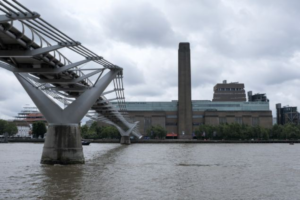CANBERRA, Australia (AP) — The Australian government took a major step toward implementing a key climate policy that would force chief greenhouse gas polluters to reduce emissions, with the minor Greens party pledging their support Monday.
The center-left Labor Party administration said the so-called Safeguard Mechanism reforms are essential to Australia reaching its target of reducing its emissions by 43% below 2005 levels by the end of the decade. The reforms would create a ceiling on the nation’s emissions and force Australia’s 215 biggest polluting facilities to reduce their emissions over time.
The Climate Council, a leading climate communicator, described the reforms as the first Australian legislation in a decade that would regulate greenhouse gas pollution.
With the support of the Greens’ 11 senators, the government only needs the backing of two unaligned or minor party senators to get the reforms through the upper chamber. Greens leader Adam Bandt said a “hard cap” on emissions would mean that half of the 116 new coal and gas projects proposed in Australia would not go ahead.
The amount of greenhouse gas emissions allowed under the cap has not been made public. The cap would be reduced over time as polluters scaled back their emissions.
“The Greens, through the negotiations, has secured a big hit on oil and gas,” Bandt told reporters as he confirmed his party’s support for the reforms.
The legislation was passed Monday by the House of Representatives, where Labor holds a majority of seats.
Prime Minister Anthony Albanese said the Safeguard Mechanism “is the vehicle to achieve our commitment for 43% reduction by 2030.”
Climate Change and Energy Minister Chris Bowen said that without the mechanism, Australia would only reduce its emissions by 35% by the end of the decade.
“Today we’re a big step closer to passing the Safeguard Mechanism reforms through Parliament,” Bowen said.
The reforms would reduce Australia’s greenhouse gas emissions by 205 million metric tons (226 million U.S. tons) by 2030, equivalent to taking two-thirds of Australia’s cars off the road in the same time, Bowen said.
Big polluters would be able to buy carbon credits to help achieve their emission reduction targets. But polluters that use carbon credits to achieve more than 30% of their abatement would have to explain why they were not doing more to reduce their own emissions.
Opposition climate change and energy spokesperson Ted O’Brien rejected the reforms, saying capping emissions would drive Australian industrial investment offshore to China and India.
“This is not a plan to decarbonize the Australian economy but rather a plan to deindustrialize it,” O’Brien said.
The conservative opposition created the Safeguard Mechanism when it was in power in 2016. But the emission limits were so high that the 215 major polluters, which account for 30% of Australia’s emissions, were able to increase their emissions by 4%.
The previous government had set a less ambitious target of reducing Australia’s emissions by only 26% to 28% below 2005 levels by 2030.
The Climate Council welcomed the Greens’ deal with the government as a historic agreement.
“This will be the Federal Parliament’s first reform to genuinely cut pollution in a decade,” Climate Council CEO Amanda McKenzie said in a statement.
The Australia Institute, a left-wing policy think tank, was critical that the reforms would allow some new fossil fuel projects to proceed, though fewer than under the current mechanism.
Greenpeace Australia Pacific spokesperson Glenn Walker said the most important task for the Australian Parliament was to rule out new fossil fuel mines in favor of clean, future-proof industries.




